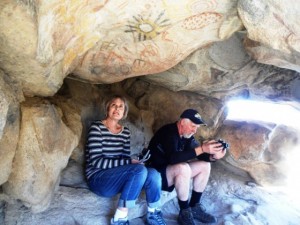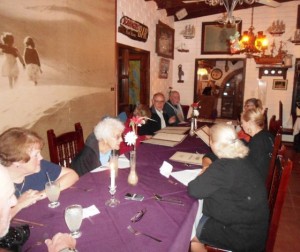
January 10, 2014 – Well it has been a busy and eventful couple of days since I last blogged. Our drive from Villarino to Fidel’s on the beach had the usual traffic, blue skies and folks really got experience driving with locals. On one of our body breaks we met 3 young boys, very polite and friendly for sure; fortunately we had 3 large candy canes we had been given at Xmas which we passed along, these kids will really enjoy these. Sadly not far from Fidel’s we had to pass a dog, still on the road, that had been hit and unable to pull itself off the pavement. It did appear one of the locals was going to assist it, unfortunately no emergency vet treatment in that dogs future.

Following our fuel up we headed off to Fidel’s, the road was firm and dry, always preferable to wet, muddy and sloppy where we have been stuck before. Did not take long for everyone to find a spot they liked and walking on the beach. Fidel brought us firewood soon after we arrived for our campfire and wiener roast. The fire was warm, the dogs hot, we also had smores, a salad and some veggies and dip, we almost stayed up until 7:30 pm!

The next day we were off to Catavina and still no wind, traffic was also less than expected, these are all good things. Before you knew it we were in Catavina heading to Santa Inez, the arroyo on the south side of town has gotten worse; unfortunately the priority of those in charge seems to be better signage warning of the road hazard instead of fixing the problem.

We arrived in Catavina, only a couple of other campers there; after we set up we headed off to the Cave Paintings. A short drive and walk had us up the embankment and looking at these remarkable images from the pre-historic past. The paintings were 6,000-9,000 years old, Baja and North America were certainly a different place at the end of the last Ice Age. After we returned to the campground we had a visit from Ralph, an American who spends his winters in Catavina in a house he built into the mountain just behind Rancho Santa Inez. Ralph has a shop with lots of tools and can be a very handy guy to know if you ever have any vehicle problems. Later the whole gang went for dinner, authentic and basic, but tasty. Marla, Matilda’s granddaughter, was the server and delightful as ever.
 The next day we started with a vehicle problem. We were not 5 minutes on the highway and Tom & Linda’s truck had issues. We went a little further but issues persisted, after some time deliberating and listening to the vehicle we decided it may be the transmission. We had the group parked safely on the road and escorted Tom & Linda back to Catavina under their own steam. By the time we reached the campground the truck was stuck in 3rd gear. On arrival Ralph was already saying good morning to some campers and new right away that we had a problem, he was right on things keen to sort out what the problem was. Fortunately Ralph has been the go to guy for the Baja Mil and been in charge of many repairs, having a Hamm radio also helps, he is in constant contact with many people across Baja and the US. We said our goodbyes to Tom & Linda, Dom & Diane will see them in 2 days and we will see where the repairs are at.
The next day we started with a vehicle problem. We were not 5 minutes on the highway and Tom & Linda’s truck had issues. We went a little further but issues persisted, after some time deliberating and listening to the vehicle we decided it may be the transmission. We had the group parked safely on the road and escorted Tom & Linda back to Catavina under their own steam. By the time we reached the campground the truck was stuck in 3rd gear. On arrival Ralph was already saying good morning to some campers and new right away that we had a problem, he was right on things keen to sort out what the problem was. Fortunately Ralph has been the go to guy for the Baja Mil and been in charge of many repairs, having a Hamm radio also helps, he is in constant contact with many people across Baja and the US. We said our goodbyes to Tom & Linda, Dom & Diane will see them in 2 days and we will see where the repairs are at.

Arrive in Guerrero Negro about 1:30pm, off to Tony’s, then Mercado, short tour of town, and back for dinner at 6pm. Dinner wonderful as always, our friends Barry & Viv from our 2012 January tour showed up and we had a couple of drinks after. They had traveled from the US that morning coming down Hwy 5, they drove over an hour in the dark and saw many cows. Remember please avoid driving in at night! Whales this morning, we are confident everyone will have a wonderful experience, blue skies, no wind and the ocean is very calm, perfect conditions.
Later today we are off to San Ignacio and Rice & Beans, we can hardly wait!
Did you know?

Two Pacific Ocean populations of the Gray Whale are known to exist. The California Gray Whale is the larger population estimated between 20,000 and 22,000 individuals in the Eastern Pacific travelling between the waters off Alaska and Baja California. Beginning in the Bering and Chukchi seas and ending in the warm-water lagoons of Mexico’s Baja peninsula, their round trip journey moves them through 12,500 miles of coastline. This journey begins each October as the northern ice pushes southward. Travelling both night and day, the Gray Whale averages approximately 120 km (80 miles) per day. By mid-December to early January, the majority of the Gray Whales are usually found between Monterey and San Diego, where they are often seen from shore. The animals travel in small groups to the coastal waters of Baja California and the southern Gulf of California, where they breed and the young are born.

By late December to early January, the first of the Gray Whales begin to arrive in the calving lagoons of Baja. The first whales to arrive are usually pregnant mothers that look for the protection of the lagoons to give birth to their calves, along with single females seeking out male companions in order to mate. By mid-February to mid-March the bulk of the Gray Whales have arrived at the lagoons. It is at this time that the lagoons are filled to capacity with nursing, calving and mating Gray Whales. The breeding behaviour is complex and often involves three or more animals. The gestation period is about one year, and females have calves every other year. The calf is born tail first and measures about 4 meters in length. It is believed that the shallow waters in the lagoons protect the newborn from sharks.

The three primary lagoons that the whales seek in Baja California are Laguna Ojo de Libre (formerly known in English as Scammon’s Lagoon), San Ignacio, and Magdalena. As noted, the Grays were called the devil fish until the Spring of 1972 when a fisherman in the Laguna San Ignacio named Francisco “Pachico” Mayoral (although terrified to death) reached out and placed his hand in the water as a Gray mother approached his fishing boat and gently “rubbed up against him”. Today the whales in all three lagoons are protected, but whale watching in the lagoons is permitted.
Throughout February and March, the first Gray Whales to leave the lagoons are the males and single females. Once they have mated, they will begin the trek back north to their summer feeding grounds in the Bering and Chukchi seas. This round trip of 16,000–22,000 km, at an average speed of 5 km/h, is believed to be the longest yearly migration of any mammal. Pregnant females and nursing mothers with their newborn calves are the last to leave the lagoons. They leave only when their calves are ready for the journey, which is usually from late March to mid-April. Often there are still a few lingering Gray Whale mothers with their young calves in the lagoons well into May.

By late March or early April a number of Gray Whales enter Puget Sound and may be seen from Canada as far south as Everett, Washington near the mouth of the Snohomish River. A population of about 2,000 Gray Whales stay along the Oregon coast throughout the summer, not making the farther trip to Alaska waters.

Between 1846 and 1874 an estimated 8,000 Gray Whales were killed by European whalers, with over half having been killed in the Magdalena Bay complex (Estero Santo Domingo, Magdalena Bay itself, and Almejas Bay) and by shore whalers in California and Baja California. This, for the most part, does not take into account the large number of calves injured or left to starve after their mothers had been killed in the breeding lagoons. Since whalers primarily targeted mothers with calves in the lagoons, several thousand should probably be added to the total. Also, shore whaling in California and Baja California continued after this period, until the early 20th century. Hunted to the edge of extinction the gray whale was given partial protection in 1937 and full protection in 1947 by the International Whaling Commission (IWC). Since that time the eastern north Pacific gray whale population has made a remarkable recovery and now numbers are probably close to their original population size.

As of 2008, the IUCN (International Union for Conservation of Nature) regards the California Gray Whale as being of “Least Concern” from a conservation perspective. There are currently about 400 whales in Scammon’s Lagoon and for the first time ever “Siamese” or conjoined twins were born which sadly died shortly after birth.


